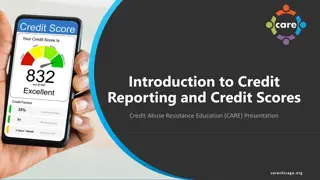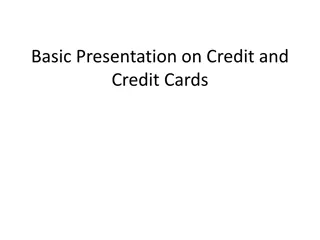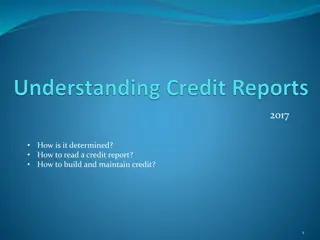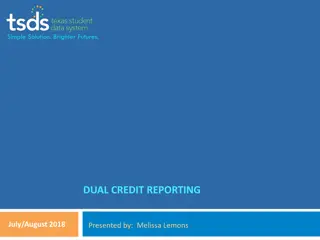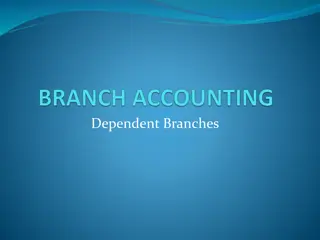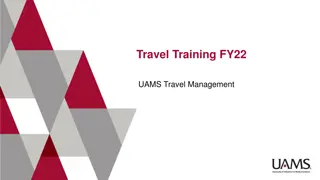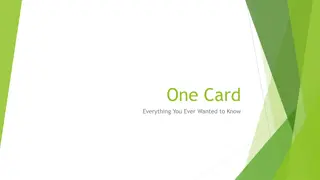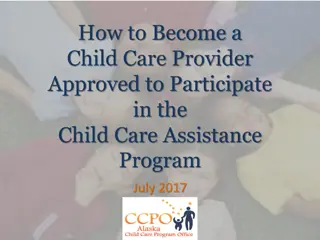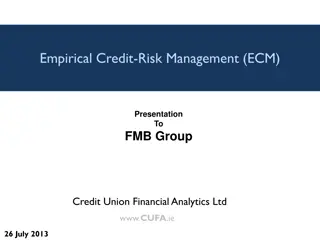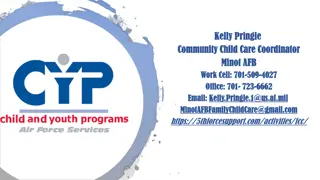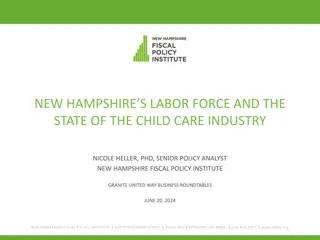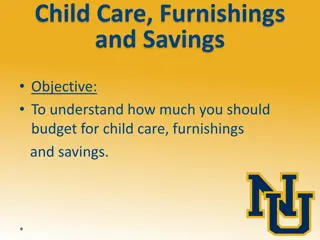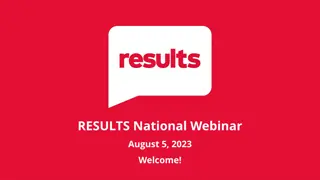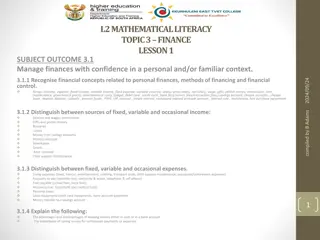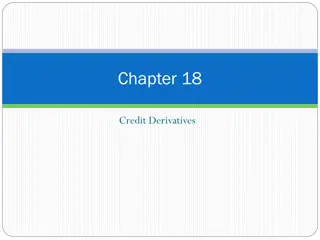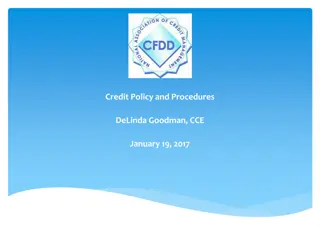Understanding Child and Dependent Care Expenses Credit
The Child and Dependent Care Expenses Credit allows taxpayers to reduce their tax liability by a portion of expenses incurred for caring for qualifying persons. Qualifying persons include children under 13, incapacitated spouses or dependents, and certain criteria must be met to claim the credit. The credit ranges from 20% to 35% of the taxpayer's expenses, with various tests and rules determining eligibility. It is a nonrefundable credit, meaning it can reduce tax owed to zero but does not result in a refund. Refer to specific qualifications, earned income tests, work-related expense tests, and provider identification tests to claim this credit.
Download Presentation

Please find below an Image/Link to download the presentation.
The content on the website is provided AS IS for your information and personal use only. It may not be sold, licensed, or shared on other websites without obtaining consent from the author. Download presentation by click this link. If you encounter any issues during the download, it is possible that the publisher has removed the file from their server.
E N D
Presentation Transcript
CREDIT FOR CHILD AND DEPENDENT CARE EXPENSES SPRING 2018, LAMC
INTRODUCTION Credit for child and dependent care expenses allows taxpayers to reduce their tax by a portion of their child and dependent care expenses. It is nonrefundable (it can only reduce tax liability to zero; no refunds). Qualifying persons for the credit are Qualifying child under 13 Spouse who is incapable of self-care Dependent who is incapable of self-care Taxpayer must be working or looking for work. Credit ranges from 20% to 35% of taxpayer s expenses.
QUALIFICATIONS Taxpayer must meet the following qualifications to take the credit: Qualifying person test Earned income test Work-related expense test Joint return test Provider identification test Refer to Publication 4012, Tab G, Nonrefundable Credits; G-5 and G-6
QUALIFICATIONS Qualifying person Dependent who is under age 13 when the care was provided. Dependent who is physically or mentally incapable of self-care Lived with the taxpayer for more than of the year. Qualified work-related expenses Taxpayer is working or looking for work Includes costs of services for qualifying person s well-being and protection Expenses to attend kindergarten or a higher grade aren t an expense for care. Summer day camp expenses are qualifying, but overnight camp are not.
QUALIFICATIONS Earned Income Test Wages Salaries Tips Other taxable employee compensation Net earnings from self-employment Strike benefits Disability pay reported as wages Taxpayer s spouse is treated as having earned income for any month the spouse is physically or mentally incapable of self- care or is a full-time student (for some part of 5 calendar months during the year). Work-related expenses Expenses are considered work-related only if both of the following are true: Expenses that allow taxpayer (and spouse, if married) to work or look for work; and Expenses are for qualifying person s care, and to provide for that person s well-being and protection.
QUALIFICATIONS If married, both spouses generally must work or be looking for work. Spouses are treated as working during any month the spouses were full- time students or mentally unable to take care of themselves. Limits to the expense: $3,000 for one qualifying person $6,000 for two or more qualifying persons (does not need to be divided equally among them).
WORK-RELATED EXPENSES Expenses that count as work-related Pre-school or home day care Before-or-after school care for a child in kindergarten or higher grade Dependent care Household expenses that are partly for well-being and protection of qualifying person (i.e. housekeeper services or cook). Non-qualified expenses Education expenses (i.e. private school) Overnight camp costs Transportation costs
CREDIT FOR CHILD AND DEPENDENT CARE EXPENSES Do not count amounts paid to: Dependent Taxpayer s child who is under age 19 at end of year, even if child is not the taxpayer dependent Taxpayer s spouse at any time during the year Other parent of taxpayer s qualifying child who is under age 13. Joint return test Generally married couples must file joint return to claim the credit. Taxpayers may be considered unmarried if they file a separate return and: Are legally separated on the last day of the tax year; or Lived apart from their spouse for the last 6 months of the year and paid more than half the cost of providing a home that was also the main home of the qualifying person for more than half the year (HOH filing status) Need provider name, address and identification number to claim credit. Due diligence to obtain this information is sufficient to claim credit.
CREDIT FOR CHILD AND DEPENDENT CARE EXPENSES Need to complete Form 2441 to claim credit: Part I: general information about the care provider Part II: where child and dependent care credit is calculated Part III: where information is entered if taxpayer reports employer-provided dependent care benefits. Employer-provided dependent care benefits: Some taxpayers receive dependent care benefits from their employer. They may be able to exclude these benefits from their income. Dependent care benefits are amounts employer pays either directly to the taxpayer or to the care provider. Appears on Form W-2. Box 10. Must complete Part III of Form 2441 first, and then Part II. Earned income limit Work-related expenses used to determine the credit cannot be more than: Taxpayer s earned income for the year; or If MFJ, the smaller of the taxpayer or spouse s earned income for the year.
EXERCISES The taxpayer paid work-related expenses for the care of their two qualifying children. The care expenses for one child was $3,200. The care expenses for the other child was $2,800. What is the total amount of work-related child care expenses the taxpayer can use when figuring the child and dependent care credit? a) $2,800 b) $3,200 c) $5,800 d) $6,000





